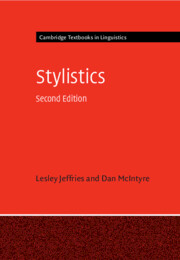Refine search
Actions for selected content:
64 results
20 - Liturgical Texts
- from Part V - The Study of Liturgy
-
-
- Book:
- The Cambridge Companion to Christian Liturgy
- Published online:
- 19 September 2025
- Print publication:
- 09 October 2025, pp 355-368
-
- Chapter
- Export citation
22 - Illuminated Manuscripts
- from Part II - Artefacts and Evidence
-
- Book:
- The Cambridge Encyclopaedia of Late Antique Art and Archaeology
- Published online:
- 04 July 2025
- Print publication:
- 31 July 2025, pp 407-420
-
- Chapter
- Export citation
33 - Legal Interpretation as Coordination
- from Part III - Applications
-
-
- Book:
- The Cambridge Handbook of Experimental Jurisprudence
- Published online:
- 17 May 2025
- Print publication:
- 05 June 2025, pp 546-577
-
- Chapter
- Export citation
11 - Rules
- from Part II - Introductions
-
-
- Book:
- The Cambridge Handbook of Experimental Jurisprudence
- Published online:
- 17 May 2025
- Print publication:
- 05 June 2025, pp 173-184
-
- Chapter
- Export citation

Stylistics
-
- Published online:
- 18 February 2025
- Print publication:
- 09 January 2025
-
- Textbook
- Export citation
Chapter 1 - What Is Discourse?
-
- Book:
- Introducing Practical Discourse Analysis
- Published online:
- 20 December 2024
- Print publication:
- 09 January 2025, pp 1-42
-
- Chapter
- Export citation
1 - History and Its Historians
-
- Book:
- Merovingian Worlds
- Published online:
- 22 November 2024
- Print publication:
- 05 December 2024, pp 29-62
-
- Chapter
- Export citation
WRITTEN ON THE BODY: ANIMATED OBJECTS AND NARRATIVE AGENCY IN PRUDENTIUS’ PERISTEPHANON 9
-
- Journal:
- The Classical Quarterly / Volume 74 / Issue 2 / December 2024
- Published online by Cambridge University Press:
- 16 April 2025, pp. 732-747
- Print publication:
- December 2024
-
- Article
-
- You have access
- Open access
- HTML
- Export citation
Chapter 7 - Materiality
-
-
- Book:
- The Cambridge Companion to Literature in a Digital Age
- Published online:
- 29 November 2024
- Print publication:
- 14 November 2024, pp 125-136
-
- Chapter
- Export citation
2 - Law as Text
-
-
- Book:
- The Cambridge Comparative History of Ancient Law
- Published online:
- 09 May 2024
- Print publication:
- 30 May 2024, pp 20-72
-
- Chapter
- Export citation
4 - Textualism
-
- Book:
- Demystifying Treaty Interpretation
- Published online:
- 07 March 2024
- Print publication:
- 14 March 2024, pp 85-100
-
- Chapter
- Export citation
Background: Historical and Textual
-
- Book:
- Three Faces of Sun Tzu
- Published online:
- 07 March 2024
- Print publication:
- 15 February 2024, pp 23-46
-
- Chapter
- Export citation
Background: Historical and Textual
-
- Book:
- Three Faces of Sun Tzu
- Published online:
- 07 March 2024
- Print publication:
- 15 February 2024, pp 23-46
-
- Chapter
- Export citation
Introduction
-
-
- Book:
- The Cambridge Companion to <i>Gulliver's Travels</i>
- Published online:
- 05 October 2023
- Print publication:
- 19 October 2023, pp 1-8
-
- Chapter
- Export citation
Chapter 9 - Annotated Immortality
- from Part V - Editing Lives, and Life
-
- Book:
- The Literary Criticism of Samuel Johnson
- Published online:
- 07 September 2023
- Print publication:
- 21 September 2023, pp 159-173
-
- Chapter
-
- You have access
- Open access
- HTML
- Export citation
8 - Texts
- from Part III - Collecting and Analysing Data
-
-
- Book:
- Conducting Research on Global Environmental Agreement-Making
- Published online:
- 07 August 2023
- Print publication:
- 10 August 2023, pp 143-167
-
- Chapter
- Export citation
5 - The Papyri
-
- Book:
- Latin Military Papyri of Dura-Europos (<i>P.Dura</i> 55–145)
- Published online:
- 21 July 2023
- Print publication:
- 10 August 2023, pp 193-658
-
- Chapter
- Export citation
Chapter 11 - Memory, Text, Affect
- from Part IV - Memory, Affect, and Stagecraft
-
-
- Book:
- Memory and Affect in Shakespeare's England
- Published online:
- 07 June 2023
- Print publication:
- 27 July 2023, pp 220-237
-
- Chapter
- Export citation
19 - Post-World War II Theater and Media
- from Part II - Forms, Genre, and Media
-
-
- Book:
- The Cambridge History of American Modernism
- Published online:
- 13 July 2023
- Print publication:
- 20 July 2023, pp 334-348
-
- Chapter
- Export citation
1 - The Multidisciplinary Field of Referring
- from Part I - The Nature of Referring and Referring Expressions
-
- Book:
- Referring in Language
- Published online:
- 22 June 2023
- Print publication:
- 25 May 2023, pp 3-22
-
- Chapter
- Export citation
